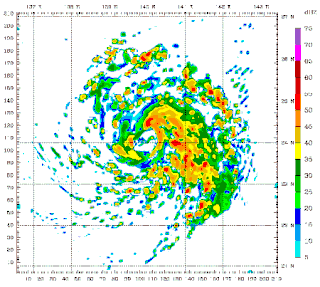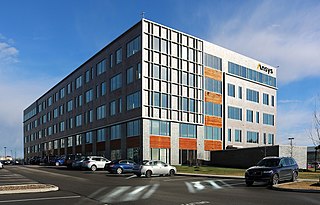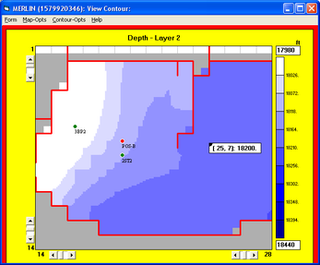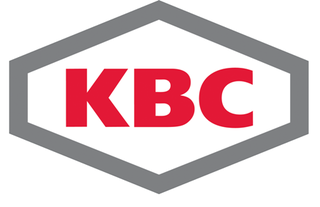
A simulation is an imitative representation of a process or system that could exist in the real world. In this broad sense, simulation can often be used interchangeably with model. Sometimes a clear distinction between the two terms is made, in which simulations require the use of models; the model represents the key characteristics or behaviors of the selected system or process, whereas the simulation represents the evolution of the model over time. Another way to distinguish between the terms is to define simulation as experimentation with the help of a model. This definition includes time-independent simulations. Often, computers are used to execute the simulation.
Autodesk, Inc. is an American multinational software corporation that provides software products and services for the architecture, engineering, construction, manufacturing, media, education, and entertainment industries. Autodesk is headquartered in San Francisco, California, and has offices worldwide. Its U.S. offices are located in the states of California, Oregon, Colorado, Texas, Michigan, New Hampshire and Massachusetts. Its Canada offices are located in the provinces of Ontario, Quebec, and Alberta.

Computer simulation is the running of a mathematical model on a computer, the model being designed to represent the behaviour of, or the outcome of, a real-world or physical system. The reliability of some mathematical models can be determined by comparing their results to the real-world outcomes they aim to predict. Computer simulations have become a useful tool for the mathematical modeling of many natural systems in physics, astrophysics, climatology, chemistry, biology and manufacturing, as well as human systems in economics, psychology, social science, health care and engineering. Simulation of a system is represented as the running of the system's model. It can be used to explore and gain new insights into new technology and to estimate the performance of systems too complex for analytical solutions.
Silvaco Group, Inc., develops and markets electronic design automation (EDA) and technology CAD (TCAD) software and semiconductor design IP (SIP). The company is headquartered in Santa Clara, California, and has offices in North America, Europe, and throughout Asia. Founded in 1984, Silvaco is a publicly traded EDA company. The company has been known by at least two other names: Silvaco International, and Silvaco Data Systems.

Ansys, Inc. is an American multinational company with its headquarters based in Canonsburg, Pennsylvania. It develops and markets CAE/multiphysics engineering simulation software for product design, testing and operation and offers its products and services to customers worldwide.

OrCAD Systems Corporation was a software company that made OrCAD, a proprietary software tool suite used primarily for electronic design automation (EDA). The software is used mainly by electronic design engineers and electronic technicians to create electronic schematics, and perform mixed-signal simulation and electronic prints for manufacturing printed circuit boards (PCBs). OrCAD was taken over by Cadence Design Systems in 1999 and was integrated with Cadence Allegro in 2005.

Reservoir simulation is an area of reservoir engineering in which computer models are used to predict the flow of fluids through porous media.
Simulation software is based on the process of modeling a real phenomenon with a set of mathematical formulas. It is, essentially, a program that allows the user to observe an operation through simulation without actually performing that operation. Simulation software is used widely to design equipment so that the final product will be as close to design specs as possible without expensive in process modification. Simulation software with real-time response is often used in gaming, but it also has important industrial applications. When the penalty for improper operation is costly, such as airplane pilots, nuclear power plant operators, or chemical plant operators, a mock up of the actual control panel is connected to a real-time simulation of the physical response, giving valuable training experience without fear of a disastrous outcome.

Cadence Design Systems, Inc. is an American multinational technology and computational software company. Headquartered in San Jose, California, Cadence was formed in 1988 through the merger of SDA Systems and ECAD. Initially specialized in electronic design automation (EDA) software for the semiconductor industry, currently the company makes software and hardware for designing products such as integrated circuits, systems on chips (SoCs), printed circuit boards, and pharmaceutical drugs, also licensing intellectual property for the electronics, aerospace, defense and automotive industries, among others.
Acceleware Ltd. is a Canadian innovator of clean-tech oil and gas technologies composed of two business units: Radio Frequency (RF) Enhanced Oil Recovery and Seismic Imaging Software. The company is currently running a commercial-scale, RF XL pilot project at Marwayne, Alberta, Canada, to advance and validate its heavy oil and oil sands electrification technology. Acceleware's seismic imaging software solutions offer imaging for oil exploration in complex geologies.
Service in Informatics and Analysis was one of the pioneering time-sharing service bureau companies in the late 1960s, later known as SIA Computer Services. Its head office was located at Lower Belgrave Street, close to Victoria Station in London, and the company had branch offices in Edinburgh, Manchester, the West End, Paris and in Hong Kong. SIA offered terminal services via the Post Office telephone network at speeds of 10, 15, 30, 60 and 120 characters per second for Teletype-style terminals and of 1200 baud, 2400 baud and 4800 baud for Remote Job Entry terminals. Later with the release of the IBM PC, systems were developed to emulate the Remote Batch and interactive terminals. Clients could also visit the head or branch offices to submit their jobs personally or have them accepted and supervised by the production department.
GoldSim is dynamic, probabilistic simulation software developed by GoldSim Technology Group. This general-purpose simulator is a hybrid of several simulation approaches, combining an extension of system dynamics with some aspects of discrete event simulation, and embedding the dynamic simulation engine within a Monte Carlo simulation framework.
ADINA is a commercial engineering simulation software program that is developed and distributed worldwide by ADINA R & D, Inc. The company was founded in 1986 by Dr. Klaus-Jürgen Bathe, and is headquartered in Watertown, Massachusetts, United States. On April 7, 2022, Bentley Systems acquired ADINA R&D, Inc.
Lanner Group Ltd is a software company specialising in simulation software such as discrete event simulation and predictive simulation, headquartered in Birmingham, UK. The business develops, markets and supports business process simulation and optimisation systems. The company has subsidiaries in the US, China, France and Germany and a distributor network selling the company's products in 20 different countries. Lanner Group was formed following a Management Buyout of AT&T Istel, a spin-off from the operational research department of British Leyland where, in 1978, the world's first visual interactive simulation tool was developed. Lanner Group services automotive, aviation, criminal justice, defence and aerospace, financial services and contact centres, food and beverage, health, logistics and supply chain, manufacturing, nuclear, oil and gas, pharmaceutical, and consumer health industries.

ESI Group provides virtual prototyping software that simulates a product's behavior during testing, manufacturing and real-life use. Engineers in a variety of industries use its software to evaluate the performance of proposed designs in the early phases of the project with the goal of identifying and eliminating potential design flaws.

KBC Advanced Technologies Ltd is a technology-based consulting company in the energy and chemical industries. It is headquartered in Walton on Thames in England and the company has offices worldwide, with major operations in Houston and Singapore. Founded in 1979 by Krikor Krikorian, John Brice, and Peter Close, the name KBC was formed by the initial letters of their surnames. In 2016, KBC was acquired by Yokogawa.
Integrated asset modelling (IAM) is the generic term used in the oil industry for computer modelling of both the subsurface and the surface elements of a field development. Historically the reservoir has always been modelled separately from the surface network and the facilities. In order to capture the interaction between those two or more standalone models, several time-consuming iterations were required. For example, a change in the water breakthrough leads to a change in the deliverability of the surface network which in turn leads to a production acceleration or deceleration in the reservoir. In order to go through this lengthy process more quickly, the industry has slowly been adopting a more integrated approach which captures the constraints imposed by the infrastructure on the network immediately.
An operator training simulator (OTS) is a computer-based training system that uses a dynamic simulation model of an industrial process, usually integrated with an emulator of the process plant's Distributed Control System (DCS).
Aspen Plus, Aspen HYSYS, ChemCad and MATLAB, PRO are the commonly used process simulators for modeling, simulation and optimization of a distillation process in the chemical industries. Distillation is the technique of preferential separation of the more volatile components from the less volatile ones in a feed followed by condensation. The vapor produced is richer in the more volatile components. The distribution of the component in the two phase is governed by the vapour-liquid equilibrium relationship. In practice, distillation may be carried out by either two principal methods. The first method is based on the production of vapor boiling the liquid mixture to be separated and condensing the vapors without allowing any liquid to return to the still. There is no reflux. The second method is based on the return of part of the condensate to still under such conditions that this returning liquid is brought into intimate contact with the vapors on their way to condenser.







